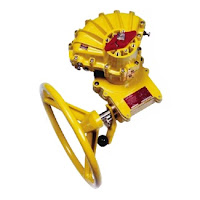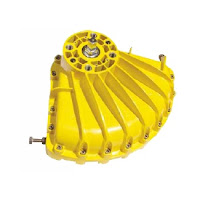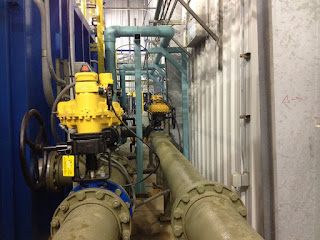The Kinetrol rotary vane design is based upon a single moving part which eliminates additional parts required to convert linear motion to rotary motion. This simple and innovative design provides a highly accurate and extremely reliable actuator for operating valves, drives and dampers, and is perfectly suited for the most demanding process control applications. For more information visit www.kinetrolusa.com or call 972-447-9443.
Showing posts with label actuation. Show all posts
Showing posts with label actuation. Show all posts
Trouble-free Pneumatic Valve and Damper Actuators
A rugged, corrosion-resistant pneumatic vane actuator with only a single moving part, the Kinetrol vane actuator is warranted to operate trouble-free for millions of cycles.
With millions of actuators performing reliably around the world, the Kinetrol vane actuator's outstanding cycle life, smooth and precise movement, and environmentally rugged design makes it the best choice for all of your automated valve requirements.
Kinetrol USA
https://kinetrolusa.com
972-447-9443
A Review: Why Kinetrol Actuators Are the Most Reliable 1/4 Turn Pneumatic Actuator on the Market Today
With millions of actuators performing reliably around the world, the Kinetrol vane actuator's are the best choice for valve and damper actuation applications that require long life and ultra-dependable performance. Here's a review as to why:
 |
| Click on image for larger view. |
- Durable epoxy stove enamel exterior finish.
- Long life epoxy or PTFE internal finish.
- Integral vane/shaft casting - only one moving part: Simplest and most reliable mechanism for quarter-turn rotary actuation.
- Manual override square and position indicator.
- Stainless steel expanders ensure long term lipseal / case contact.
- Double opposed, Polyurethane, lip seals for effective sealing and long maintenance free life.
- Space filling/energy absorbent sideplates (polymer or metal).
- Corrosion resistant zinc (non-incendive) or aluminum alloy case.
- Easy stop adjustment at each end of stroke for accurate seating.
- Close couple control modules. Fail-safe spring returns, limit switches, positioners and solenoid valves all close couple to the actuators.
- No cranks or gearing. No power loss or backlash - allows accurate positioning.
- Long maintenance-free life. Up to 4 million operations guaranteed.
- Compact - space saving - efficient. Best torque/size package available, fast operating speeds, best air consumption, proven design.
- Unique serial number for identification and traceability.
For more information, visit https://kinetrolusa.com of call 972-447-9443.
Who makes the most reliable industrial valve actuator?
With millions of actuators performing reliably around the world, the Kinetrol vane actuator's outstanding cycle life, smooth and precise movement, and environmentally rugged design makes it the best choice for all of your valve actuation needs.
https://kinetrolusa.com
https://kinetrolusa.com
Industrial Valve Actuator Types
 |
| Lever actuator (with failsafe spring return) |
Manual
Manual actuators are capable of placing the valve in any position but do not permit automatic operation. The most common type mechanical actuator is the handwheel. This type includes handwheels fixed to the stem and handwheels connected to the stem through gears.
Electric Motor Actuators
 |
| Gear operator (attached to pneumatic actuator) |
Electric motors permit manual, semi-automatic, and automatic operation of the valve. Motors are used mostly for open-close functions, although they are adaptable to positioning the valve to any point opening. The motor is usually a, reversible, high speed type connected through a gear train to reduce the motor speed and thereby increase the torque at the stem. Direction of motor rotation determines direction of disk motion. The electrical actuation can be semi-automatic, as when the motor is started by a control system. A handwheel, which can be engaged to the gear train, provides for manual operating of the valve. Limit switches are normally provided to stop the motor automatically at full open and full closed valve positions. Limit switches are operated either physically by position of the valve or torsionally by torque of the motor.
Pneumatic Actuators
 |
| Pneumatic actuator |
Hydraulic Actuators
Hydraulic actuators provide for semi-automatic or automatic positioning of the valve, similar to the pneumatic actuators. These actuators use a piston to convert a signal pressure into valve stem motion. Hydraulic fluid is fed to either side of the piston while the other side is drained or bled. Water or oil is used as the hydraulic fluid. Solenoid valves are typically used for automatic control of the hydraulic fluid to direct either opening or closing of the valve. Manual valves can also be used for controlling the hydraulic fluid; thus providing semi-automatic operation.
Solenoid Actuated Valves
 |
| Solenoid valve (attached to pneumatic actuator) |
Single solenoid valves are termed fail open or fail closed depending on the position of the valve with the solenoid de-energized. Fail open solenoid valves are opened by spring pressure and closed by energizing the solenoid. Fail closed solenoid valves are closed by spring pressure and opened by energizing the solenoid. Double solenoid valves typically fail "as is." That is, the valve position does not change when both solenoids are de-energized.
One application of solenoid valves is in air systems such as those used to supply air to pneumatic valve actuators. The solenoid valves are used to control the air supply to the pneumatic actuator and thus the position of the pneumatic actuated valve.
Contact Kinetrol USA for any valve actuation challenge. They can be reached at https://kinetrolusa.com or by calling 972-447-9443.
Kinetrol Product Catalog October 2017
Most recent version of Kinetrol catalog including Blueline coating for foodservice applications. Kinetrol rotary vane actuators are used to operate or position ball, butterfly and plug valves, ventilation dampers and automatic doors. Uses also include movement and positioning of components during manufacture - in fact anything that needs to be turned through 90° or less, automatically or by remote control.
You can download the Kinetrol Product Catalog from the Kinetrol USA site here.
You can download the Kinetrol Product Catalog from the Kinetrol USA site here.
Labels:
actuation,
actuator,
automation,
food and beverage,
industrial,
valve
The Role of Industrial Valve Actuators
Thanks to actuators, multiple valves can be controlled in a process system in a coordinated fashion; imagine if, in a large industrial environment, engineers had to physically adjust every valve via a hand wheel or lever! While that manual arrangement may create jobs, it is, unfortunately, completely impractical from a logistical and economic perspective. Actuators enable automation to be applied to valve operation.
 |
| Pneumatic vane actuator with spring return and positioner on plastic body valve. |
Pressurized-liquid reliant devices are known as hydraulic actuators. Electric actuators, either motor driven or solenoid operated, rely on electric power to drive the valve trim into position. With controllers constantly monitoring a process, evaluating inputs, changes in valve position can be remotely controlled to provide the needed response to maintain the desired process condition.
Manual operation and regulation of valves is becoming less prevalent as automation continues to gain traction throughout every industry. Valve actuators serve as the interface between the control intelligence and the physical movement of the valve. The timeliness and automation advantages of the valve actuators also serve as an immense help in risk mitigation, where, as long as the system is functioning correctly, critical calamities in either environmental conditions or to a facility can be pre-empted and quickly prevented. Generally speaking, manual actuators rely on hand operation of levers, gears, or wheels, but valves which are frequently changed (or which exist in remote areas) benefit from an automatic actuator with an external power source for a myriad of practical reasons, most pressingly being located in an area mostly impractical for manual operation or complicated by hazardous conditions.
Thanks to their versatility and stratified uses, actuators serve as industrial keystones to, arguably, one of the most important control elements of industries around the world. Just as industries are the backbones of societies, valves are key building blocks to industrial processes, with actuators as an invaluable device ensuring both safe and precise operation.
The ISO 5211 Valve Mounting Flange and Actuator Connection
 |
| Valve with ISO 5211 Flange |
A standard interface between actuator, valve, solenoids, and positioners provides many benefits. Actuated valve assemblies are installed in a very wide range of applications and operating conditions resulting in many custom designs. Understanding the connection between these components is critical for long life, safety, and performance.
A standard mounting / connecting device lowers inventory costs and allows for faster maintenance and repair. Standardization also allows for the replacement of brands, so long as both adapt to the standard. Finally, using industry standard adapters maintain consistent specifications and tolerances which improve performance by reducing hysteresis and mechanical wear.
Kinetrol manufactures an ISO adapter for its models 02, 03, 05, 07, 08 and 09 which allows for mounting ISO 5211 valves directly to standard Kinetrol double acting actuators.
For more information about Kinetrol's ISO adapter, please review the document below.
Segment Ball Control Valve with Vane Actuator, Pneumatic Positioner, and I/P Transmitter
 |
| Actuator and Positioner |
In most cases standard ball, plug, or butterfly valves are not the best choice as control valves (where the process media has to be modulated or throttled). Standard ball, plug and butterfly valves usually introduce very non-linear, dynamic flow coefficients. Furthermore, they can introduce undesirable turbulence to your piping system.
As a means to linearize flow coefficients and reduce turbulent flow, the machining, or characterization, of the valve disk is done so that the machined shape allows for more optimized flow.
For ball valves in particular, machining the ball's flow port with a "V", or even by machining the ball more radically, can deliver excellent flow curves. A term for a more radically machined ball is the "segment ball" (sometimes called "segmented"). In the following video you can see how a Kinetrol pneumatic actuator, postioner, and I/P transmitter team up with a segment ball valve foe an excellent control valve.
Labels:
actuation,
automation,
ball,
butterfly,
control valve,
Kinetrol,
plug,
segment,
V port,
valve
Subscribe to:
Comments (Atom)


